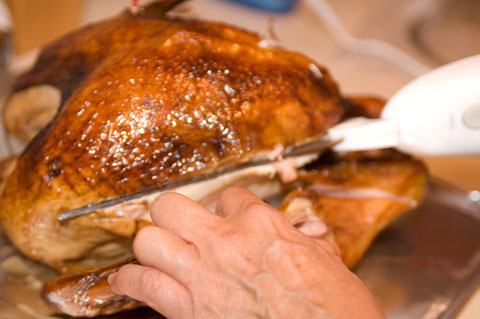Changing Turkeys' Diets Can Prevent Food Poisoning

Thanksgiving turkeys — and other poultry — are less likely to be contaminated with bacteria that can cause food poisoning if the birds chowed on natural feed ingredients, scientists have found.
About 76 million cases of food poisoning occur in the United States every year, according to the U.S. Centers for Disease Control and Prevention.
Outbreaks of various pathogens traced to spinach, peanut butter, tomatoes, jalapeño peppers, and other foods have grabbed headlines in recent years. But plants aren't the only food that can become contaminated by disease-causing microbes. Meat can be just as dangerous if not handled properly
"Food-borne pathogens are very prevalent in a lot of our domestic animals, and especially in poultry," said Dan Donoghue of the University of Arkansas in the American Chemical Society's Global Challenges podcast.
The two biggest bacterial contaminants of poultry are the well-known Salmonella, and the perhaps less well-known Campylobacter, which is actually the No. 1 cause of food poisoning in the United States and the world. Signs of food poisoning include vomiting and diarrhea.
Tougher of the two
These invisible bugs aren't generally a problem when enjoying some roast turkey on Thanksgiving because cooking tends to kill them. But if cooks get sloppy when handling raw birds, the bacteria can be transferred to cooking utensils or other foods, potentially making dinner guests sick to their stomachs.
Sign up for the Live Science daily newsletter now
Get the world’s most fascinating discoveries delivered straight to your inbox.
Campylobacter has been the tougher of the two bacteria to eliminate from poultry because it can't be eradicated with antibiotics like Salmonella can.
"With poultry, until recently, we haven't had any treatments at all for Campylobacter because it's a normal microflora, so when you use an antibiotic it may reduce the concentration, but not eliminate it," Donoghue said.
Since antibiotics weren't doing the trick, Donoghue decided to see if changing the birds' diet would make a difference — and according to results he and his colleagues published earlier this year (in the July issue of the journal Applied and Environmental Microbiology), it did.
They fed the birds natural feed ingredients, specifically a compound called caprylic acid.
"It’s a medium-chain fatty acid, it's found in cow's milk, and in coconut milk, and it has antibacterial activity," Donoghue said. "We found that when you add it to the diet of poultry, it seems to consistently inhibit or reduce Campylobacter colonization of poultry."
Donoghue and his colleagues will publish further research on the antibacterial feed in an upcoming issue of the journal Poultry Science.
Turkey tips
Proper handling and cooking of poultry provides protection against this bacteria, as it does against many viruses and bacteria, including Salmonella and E. coli. A good-quality food thermometer is an important tool for anyone who cooks poultry, experts say.
Here are the USDA recommendations:
- Wash hands before and after handling food.
- Keeping raw meat, poultry, fish, and their juices away from other food.
- After cutting raw meats, wash hands, cutting board, knife, and counter tops with hot, soapy water.
- Sanitize cutting boards by using a solution of 1 teaspoon chlorine bleach in 1 quart of water.
- Use a food thermometer to ensure food has reached the proper temperature. Cook whole birds to 180 degrees Fahrenheit; breasts to 170 F; drumsticks, thighs and wings to 180 F; and a minimum oven temperature of 325 F.
- Top 10 Mysterious Diseases
- Thankgiving Myth: Turkey Makes You Sleepy
- Why Is Dark Meat Dark?

Andrea Thompson is an associate editor at Scientific American, where she covers sustainability, energy and the environment. Prior to that, she was a senior writer covering climate science at Climate Central and a reporter and editor at Live Science, where she primarily covered Earth science and the environment. She holds a graduate degree in science health and environmental reporting from New York University, as well as a bachelor of science and and masters of science in atmospheric chemistry from the Georgia Institute of Technology.









